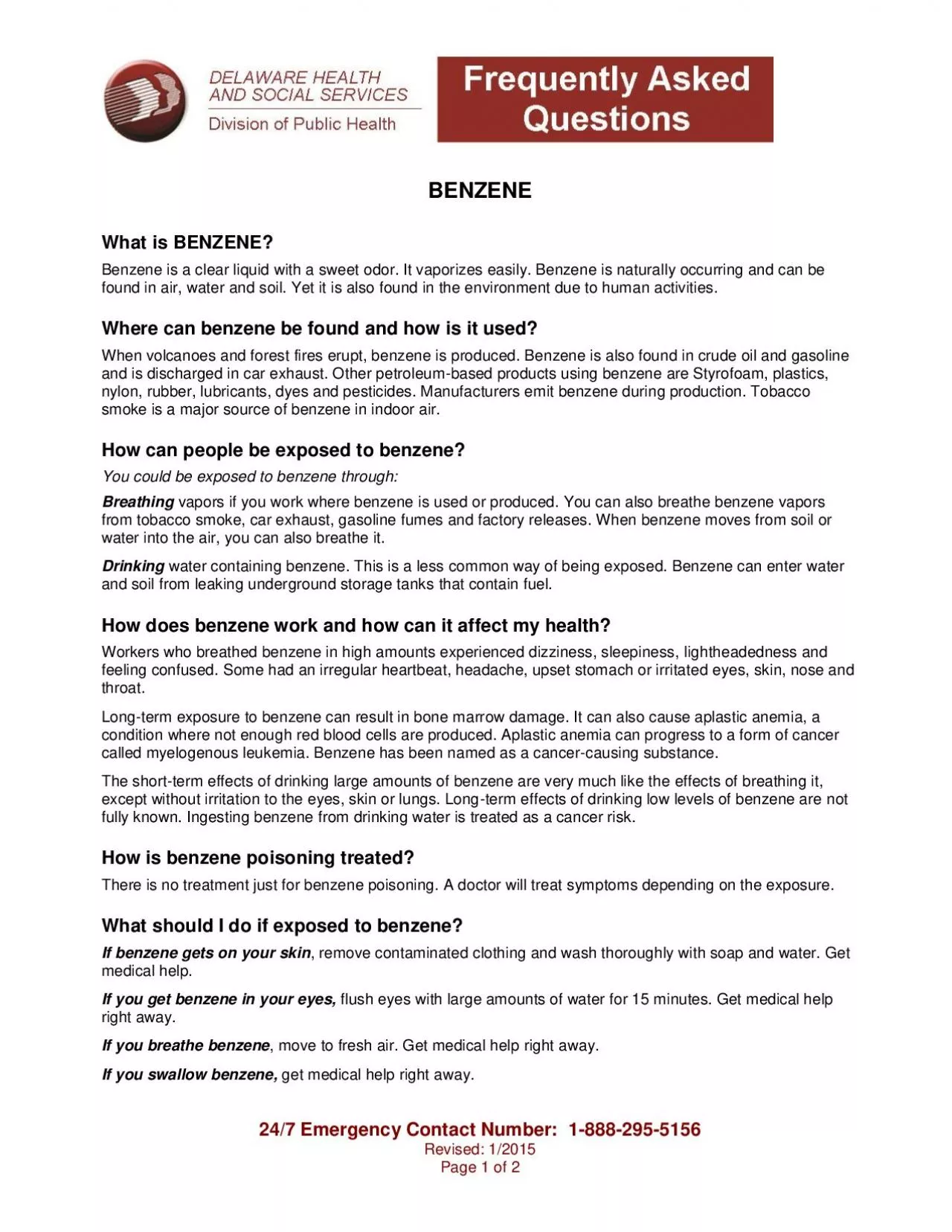

1 888 295 5156 Revised 12015 Page 1 of 2 BENZENE What is BENZENE found in air water and soil Yet it is also found in the environment due to human activities Where can benzene be fou nd ID: 937575
Download Pdf The PPT/PDF document "247 Emergency Contact Number" is the property of its rightful owner. Permission is granted to download and print the materials on this web site for personal, non-commercial use only, and to display it on your personal computer provided you do not modify the materials and that you retain all copyright notices contained in the materials. By downloading content from our website, you accept the terms of this agreement.
24/7 Emergency Contact Number: 1 - 888 - 295 - 5156 Revised: 1/2015 Page 1 of 2 BENZENE What is BENZENE ? found in air, water and soil. Yet it is also found in the environment due to human activities. Where can benzene be fou nd and how is it used? When volcanoes and forest fires erupt, benzene is produced. Benzene is also found in crude oil and gasoline and is discharged in car exhaust. Other petroleum - based products using benzene are Styrofoam, plastics, nylon, rubber, lubri smoke is a major source of benzene in indoor air. How can people be exposed to benzene? You could be exposed to benzene through: Breathing vapors if you work where benzene is used or produced. You can also breathe benzene vapors from tobacco smoke, car exhaust, gasoline fumes and factory releases. When benzene moves from soil or Drinking water containing benzene. This is a less common way of being exposed. Benzene can enter water and soil from leaking underground storage tanks that contain fuel . How does benzene work and how can it affect my health? Workers who breathed benzene in high amounts experienced dizziness, sleepiness, feeling confused. Some had an irregular heartbeat, headache, upset stomach or irritat ed eyes, skin, nose and throat. Long - term exposure to benzene can result in bone marrow damage. It can also cause aplastic anemia, a condition where not enough red blood cells are produced. Aplastic anemia can progress to a form of cancer called myelogenous leukemia. Benzene has been named as a cancer - The short - term effects of drinking large amounts of benzene are very much like th e effects of breathing it, except without irritation to the eyes, skin or lungs. Long - term effects of drinking low levels of benzene are not fully known. Ingesting benzene from drinking water is treated as a cancer risk. How is benzene poisoning treated? There is no treatment just for benzene poisoning. A doctor will treat symptoms depending on the exposure. Wh
at should I do if exposed to benzene? If benzene gets on your skin , remove contaminated clothing and wash thoroughly with soap and water. Get med ical help. If you get benzene in your eyes, flush eyes right away . If you breathe benzene , move to fresh air. Get medical help right away . If you swallow benzene, get medical help right away. 24/7 Emergency Contact Number: 1 - 888 - 295 - 5156 Revised: 1/2015 Page 2 of 2 What factors limit use or exposure to benzene? At work, exposure can be reduced by following health and safety rules and using respirators and other personal protective equipment. Limit contact with gasoline and cigarette smoke. Families are encouraged not to smoke or allow smoking in their house, in enclosed environments such as their vehicles, or near their children. Is there a medical test to show whether I’ve been exposed to benzene? Benzene can be measured in the breath and in the blood. Technic al information for benzene CAS Number: 71 - 43 - 2 Chemical Formula: C 6 H 6 Carcinogenicity (EPA): A – Human Carcinogen MCL (Drinking Water): 5 ppb OSHA Standards: 1 ppm (8 - hour time - weighted average) NIOSH Standards: 0.1 ppm (8 - hour time - weighted average) ; 15 Min Short - Term Exposure Limit: 1 ppm ACGIH: 8 hr. Time Weighted Avg. (TWA): 0.5 ppm References and Sources Agency for Toxic Substances and Disease Registry (ATSDR). 2005. Toxicological Profile for Benzene. (Draft for Public Comment). Atlanta, GA: U .S. Department of Health and Human Services. U.S. Environmental Protection Agency. Drinking Water and Health – Consumer Fact Sheet on Benzene. On - line version, http://www.epa.gov/ safewater/contaminants/dw_contamfs/benzene.html , revised January 26, 1998. (a ccessed 9/25/09) New Jersey Department of Health and Senior Services. Hazardous Substances Fact Sheet: Benzene. On - line version, http://nj.gov/health/eoh/rtkweb/documents/fs/0197.pdf , January 1998. (accessed 9/25/09